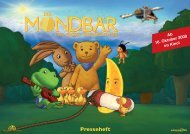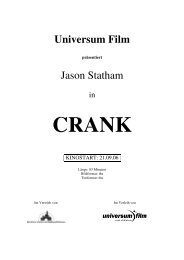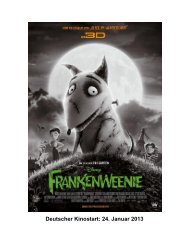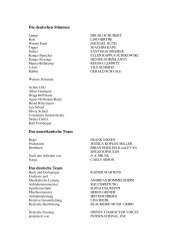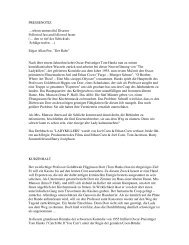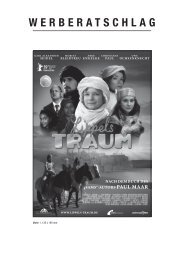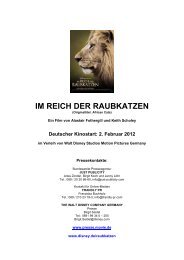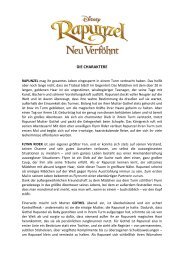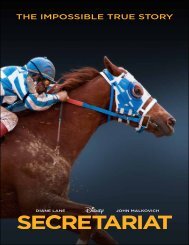The Greatest Game Ever Played - Walt Disney Studios Motion ...
The Greatest Game Ever Played - Walt Disney Studios Motion ...
The Greatest Game Ever Played - Walt Disney Studios Motion ...
You also want an ePaper? Increase the reach of your titles
YUMPU automatically turns print PDFs into web optimized ePapers that Google loves.
FORE!<br />
the Western-style gunfight effects Paxton had envisioned. “<strong>The</strong> playoff sequence between<br />
Vardon and Francis is photographed very much like a shoot-’em-out,” Berardi explains. “<strong>The</strong><br />
timing and the sense of framing really echo that style. And then we go in with a tight, Sergio<br />
Leone-type close-up to enhance this feeling.”<br />
Contrasting with the tight intensity of the<br />
golfing action sequences are the sweeping period<br />
sets of François Séguin, who created two very<br />
different worlds for THE GREATEST GAME<br />
EVER PLAYED: the posh and polished world of<br />
the wealthy, high-living “Haves”; and the much<br />
grittier, grimier, tougher world of the “Have Nots,”<br />
from where Francis Ouimet emerges.<br />
“When Francis first enters the golf club<br />
he sees this whole fancy way of life that he<br />
immediately dreams he can be a part of one<br />
day,” notes Séguin. “It was important to<br />
really highlight the contrast between<br />
Francis’s two settings and to bring the<br />
extreme elegance of the golf world at that time to life.”<br />
Séguin found himself designing a remarkable range of sets—from Francis Ouimet’s modest<br />
little Brookline house to Harry Vardon’s rustic English seaside cottage (which Séguin’s team<br />
built from scratch) to turn-of-the-century department stores and lavish country clubs.<br />
Throughout, he was inspired by the WPA photographs that Bill Paxton had brought him—with<br />
their vividly saturated bright colors and inky blacks. “He showed me these photographs from<br />
the ’30s and ’40s that had that Kodachrome look to them,” he recalls. “Bill was really seduced<br />
by those colors—so we created the palette for the whole film from those photos, which was<br />
an interesting challenge.”<br />
Producer Larry Brezner found himself transported by Séguin’s design of the Brookline<br />
Country Club circa 1913. “<strong>Ever</strong>y detail was fascinating and there was so much research that<br />
went into it,” he says. “It had such a beautiful look that the club actually wanted to keep some<br />
of what we did!”<br />
Costume designer Renée April also had a lot of fun exploring the stylish period—including<br />
the typical golf uniform of the day. It was a challenge that would take her around the world,<br />
as she scoured costume houses for authentic outfits of this rarely recreated era, from the sackcloth<br />
knickers of a working-class American to the tweed English jackets of golf pros.<br />
April enjoyed dressing Shia LaBeouf as Francis Ouimet, referring back to historical<br />
photographs of the 20-year-old hero to keep it real. “Shia’s clothes are typical of what a young<br />
poor kid would have worn. <strong>The</strong>y’re very simple but it was a lot of fun fitting Shia because at<br />
first he was quite surprised by the outfits and then we watched him grow more and more<br />
comfortable with them as he grew into the role,” she recalls.<br />
<strong>The</strong> feminine fashions of the turn-of-the-century period were especially attractive to April.<br />
20



